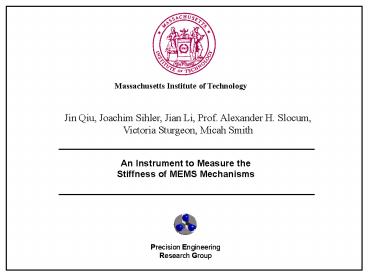Precision Engineering Research Group PowerPoint PPT Presentation
1 / 23
Title: Precision Engineering Research Group
1
Massachusetts Institute of Technology
Jin Qiu, Joachim Sihler, Jian Li, Prof. Alexander
H. Slocum, Victoria Sturgeon, Micah Smith
An Instrument to Measure the Stiffness of MEMS
Mechanisms
Precision Engineering Research Group
2
- Motivation
- Design of the Prototype
- Measurement Results
- Conclusions and Future work
Presentation Outline
Precision Engineering Research Group
3
Actuation force causes deflection
Double Beam Initial shape after DRIE with no
internal stress
Through Etch
Initial apex height 60 micron
Snap through
Silicon
Second stable position after snap through
Click for a movie
The Bistable Mechanism
Precision Engineering Research Group
4
Designed thickness 10 µm Apex height 60
µm Lengh 3 mm Depth 490 µm
Theoretical Data(assumes perfectly fabricated
cross section)
Precision Engineering Research Group
5
Front side
Back side
Fabrication Imperfectness
Precision Engineering Research Group
6
- Verify / Adjust the theoretical model
- To our knowledge, there is no existing instrument
available for in plane measurement - Generic instrument for MEMS stiffness tests
Motivation Summary
Precision Engineering Research Group
7
Fundamental goal Measure the stiffness of a MEMS
flexure
MEMS flexure
D
Fundamental Goal
Precision Engineering Research Group
8
- Design requirements
- Measure the double-beam structure
- ? Force resolution 0.1mN
- ? Displacement resolution 0.1 µm
- Working volume 4 wafers
- Generically applicable
- ? Scaleable (force displacement range)
- Perfectly lateral motion of mechanical contact
- Measure negative stiffness
- Economically manufacturable
Design Requirements
Precision Engineering Research Group
9
reference flexure
MEMS flexure
0
1
2
3
4
5
6
7
8
9
9
8
7
6
5
4
3
2
1
0
D
FMEMSkref d2
?d1-d2
0
1
2
3
4
5
6
7
8
9
9
8
7
6
5
4
3
2
1
0
d
d
2
1
Fundamental Principle
Precision Engineering Research Group
10
Design Equations
Amplification lever
(Actual behavior mapped through calibration)
Reference flexure
MEMS device
Probe Assembly with Reference Flexure
and Amplification Lever
Precision Engineering Research Group
11
Design Evolution
Precision Engineering Research Group
12
OMAX Machining Center
Precision Engineering Research Group
13
Instrument Fabrication
Precision Engineering Research Group
14
Waterjet cut aluminum flexures
Prototype
Precision Engineering Research Group
15
Prototype Details
Precision Engineering Research Group
16
Resolution 100 nm 0.1µm ? 0.1 mV (Op amp based
I-V converter)
Colin J.H. Brenan et al. Characterization and
use of a novel optical position sensor for
microposition control of a linear motor , Rev.
Sci. Instrum. 64(2), February 1993.
Barcode Readers used as Displacement Sensors
Precision Engineering Research Group
17
Create a first look-up table
Displacement (micrometer reading)
V2
Voltage V1
X X X X . . .
Y Y Y Y . . .
V1
Calibrated flexure
Calibration Step 1
Precision Engineering Research Group
18
Create a second look-up table
V2
Displacement (micrometer reading)
Voltage V1
Voltage V2
Z Z Z Z . . .
X X X X . . .
Y Y Y Y . . .
V1
Tip locked
Calibration Step 2
Precision Engineering Research Group
19
V2
V1
Precision Force Gauge (represented by a spring)
Calibration Step 3
Precision Engineering Research Group
20
VI-Interface (Labview)
Precision Engineering Research Group
21
Theoretical Data for 6.7 micron thick beam
Theoretical Data for 6.0 micron thick beam
Experimental Data
Measurement Data
Precision Engineering Research Group
22
- Proof of Concept Successfully recorded F-d curve
in real time - Resolution high enough to characterize the double
beam MEMS structure - Effective way for in-plane stiffness test of MEMS
devices - Ability to record negative stiffness (negative
F-d-slope)
Conclusions
Precision Engineering Research Group
23
- Adjustability for different force and
displacement ranges - ( current setup 0.1mN.1N, 100nm.1mm )
- Measurement perpendicular to the wafer surface
- Decrease overall size
- Integrate imaging system for easier initial
positioning - Automation of data acquisition cycle (stepper
motor drives) - Need to find a more accurate way for calibration
Future Work
Precision Engineering Research Group

